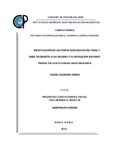Identificación de las etapas fenológicas del frijol y haba tolerantes a las heladas y su mitigación mediante productos con potencial anticongelante.
Abstract
Los objetivos de la investigación fueron los siguientes: i) comparar el daño producido en el vástago y raíz de variedades de frijol negro criollo (provenientes de clima cálido y templado) por una helada en las etapas V2, V3 y V4 ; ii) determinar las etapas fenológicas más tolerantes a las heladas en frijol y haba bajo condiciones controladas; iii) evaluar el efecto protector de sustancias anticongelantes [antincongelante (An), aminoácidos (Am), giberelinas (Gib) y la combinación de ellas con lombricomposta (Lom)] en el vástago y raíz del frijol al ser aplicadas en las etapas más sensibles y tolerantes de la especie y iv) determinar en campo el efecto de estas sustancias en los componentes del rendimiento de haba. La helada fue simulada en una cámara de crecimiento, introduciendo las plantas en distintas etapas fenológicas a una temperatura de 0°C por 90 min; 48 h después del fenómeno, se evaluaron los daños mediante una escala porcentual entre 0 = planta sana y 100 = planta muerta. En raíz se realizó una tinción con sal de tetrazolio para determinar nódulos activos e inactivos. En las etapas más tolerantes y sensibles a la helada, en las plantas se realizaron dos aplicaciones de sustancias con efecto anticongelante; a las 96 h de la primera aplicación se simuló la helada, 48 h después se evaluó el daño en el vástago y raíz. En campo, los productos fueron aplicados en haba amarilla en las etapas V13, R50 y R70. Las variedades de frijol de clima cálido presentaron mayor daño por la helada, la etapa V2 fue la más tolerante en todas las variedades; el haba presentó daño en la etapa R63; en frijol, las etapas V1 y V2 fueron las más tolerantes y V4 la más sensible, en las etapas R6 y R7 hubo daños irreversibles en las flores y vainas. Los tratamientos Lom+An, Am y Lom brindaron mayor protección en la etapa V2, en la etapa V3, con Lom+An no se presentó daño en el vástago; con Gib el daño fue el más alto, en la etapa R6 con Lom se presentó el menor daño y en R7 fue con An. En los nódulos no fue evidente el daño por la helada debido a que la temperatura promedio en los sustratos fue mayor a 12°C. En campo, el mayor peso de grano/planta de haba se detectó con la aplicación de Am y el menor peso se obtuvo con el testigo y An. _______________ IDENTIFICATION OF PHENOLOGICAL STAGES OF BEAN AND FABA BEAN TOLERANT TO FROSTS AND ITS MITIGATION BY MEANS OF PRODUCTS WITH ANTIFREEZING POTENTIAL. ABSTRACT: The objectives of this research were the following: i) to compare the damage caused on the shoot and root of native black bean varieties (from warm and cold climates) by a frost in the stages V2, V3 and V4; ii) to determine the phenological stages more tolerant to frosts in bean and faba bean under controlled conditions; iii) to evaluate the protective effect of antifreeze substances [antifreeze (An), amino acids (Am), gibberellins (Gib) and their combination with vermicompost (Lom)] on the shoot and root of bean when applied in the most sensitive and tolerant stages of the species, and iv) to determine, under field conditions, the effect of these substances on the yield components of faba bean. The frost was simulated in a growth chamber by introducing the plants in different phenological stages at a temperature of 0°C for 90 minutes; 48 hours after the phenomenon, the damages were evaluated using a percentage scale between 0 = healthy plant and 100 = dead plant. The root was stained with tetrazolium salt to determine active and inactive nodules. At the most frost -tolerant and -sensitive stages, two applications of antifreeze substances were made to the plants; 96 hours after the first application, the frost was simulated; 48 hours later, shoot and root damage was evaluated. In the field, the products were applied in yellow faba bean at stages V13, R50 and R70. The bean varieties from warm climates were more affected by the frost, the V2 stage was the most tolerant in all varieties, the faba bean showed damages in R63 stage; in bean, the stages V1 and V2 were the most tolerant, and V4 was the most sensitive; in stages R6 and R7 there was an irreversible damage in flowers and pods. The treatments Lom+An, Am and Lom provided more protection in the V2 stage. In the V3 stage, no damage to the shoot occurred when Lom+An was used; with Gib the damage was the highest; the lowest damage in the R6 stage was obtained with Lom, and in R7 with An. In the nodules the frost damage was not evident because the average temperature in the substrates was higher than 12°C. In the field, the highest weight of grain/plant in faba bean was obtained with application of Am; the lowest weight was obtained with the control and An.
Collections
- Tesis MC, MT, MP y DC [398]


